In the Austrian Bundesliga, the 12 teams get divided into two groups after the opening 22 matchday.
While the first six clubs fight for the title and the qualification for the UEFA Champions League and the UEFA Europa League, the other six teams are part of the relegation group.
The points of all clubs get halved and due to that the margins between the teams also got smaller.
After this opening 22 games and ahead of the break due to the coronavirus, LASK Linz sat in the first position ahead of RB Salzburg, but due to their infringement (had a training match even though this wasn’t allowed), they lost six points and they also lost their first game after the pause against Hartberg.
Meanwhile, Wolfsberger AC won the first game after the restart against Sturm Graz.
Considering this, ahead of this game WAC were in the second position with 22 points and LASK Linz directly behind them with 21 points. Therefore, this match was quite important for both sides.
In this tactical analysis, we will look at the tactics of both teams and explain the reasons for the 3-3 draw.
Line-ups
Both sides went with their usual formations. Ferdinand Feldhofer used once more the 4-diamond-2 formation with Alexander Kofler between the sticks and the back four was made up of Lukas Schmitz, Nemanja Rnić, Dominik Baumgartner, and Michael Novak. Mario Leitgeb was the defensive midfielder and was supported by Romano Schmid (loanee of Bundesliga club Werder Bremen) and Miloš Jojić in the centre. Michael Liendl was the number 10 behind the duo of Shon Weissman and Cheikou Dieng. We will talk about the positioning of these three men during the defensive phase in more detail later in this tactical analysis.
On the other side, Valérien Ismaël lined up his men in their typical 3-4-3 formation. The back three in front of Alexander Schlager was made of Philipp Wiesinger, Gernot Trauner, and Christian Ramsebner. James Holland and Peter Michorl occupied the centre while René Renner and Reinhold Ranftl were the wing-backs. The front three was made of Dominik Frieser, Marko Raguž, and Husein Balić.
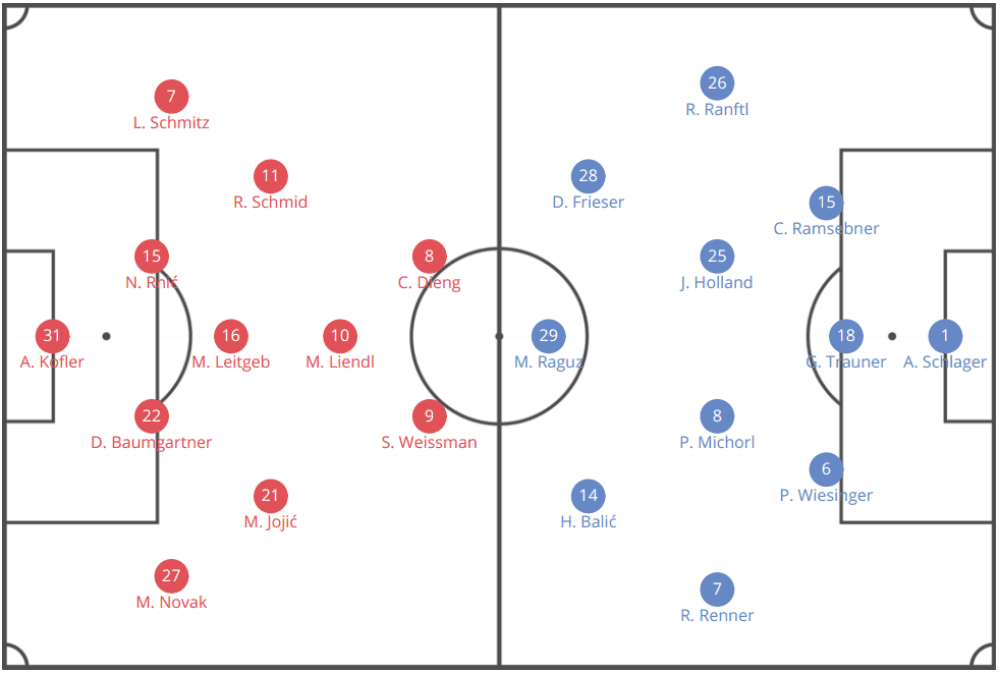
The possession phase of LASK Linz
First of all, I need to note that this game was as hectic and as intense as expected since both teams are well-known for their aggressive pressing and high-intensity style of play. Both teams were rarely able to get control of the game for a longer period and also none of them was over the 90 minutes clearly the better side. For some minutes LASK were better while in other short periods WAC had the control. This also gets visible in some stats since both had a PPDA-value smaller than seven (6.94 and 6.25), and Wolfsberger A had on average 2.93 passes per possession while LASK had a value of 3.44.
Interestingly, during the build-up phase of LASK Linz, the two strikers of WAC split and Liendl positioned between these two to create a kind of a front three. The idea behind this front three was to have in this line the exact same amount of players as LASK had in their first line. Therefore, we saw a 3 vs 3 situation in the first phase of the build-up and additionally Schmid and Jojić were positioned near Michorl and Holland as we can see in the in-game example below. WAC mostly already put pressure on LASK’s back three very high up the pitch.
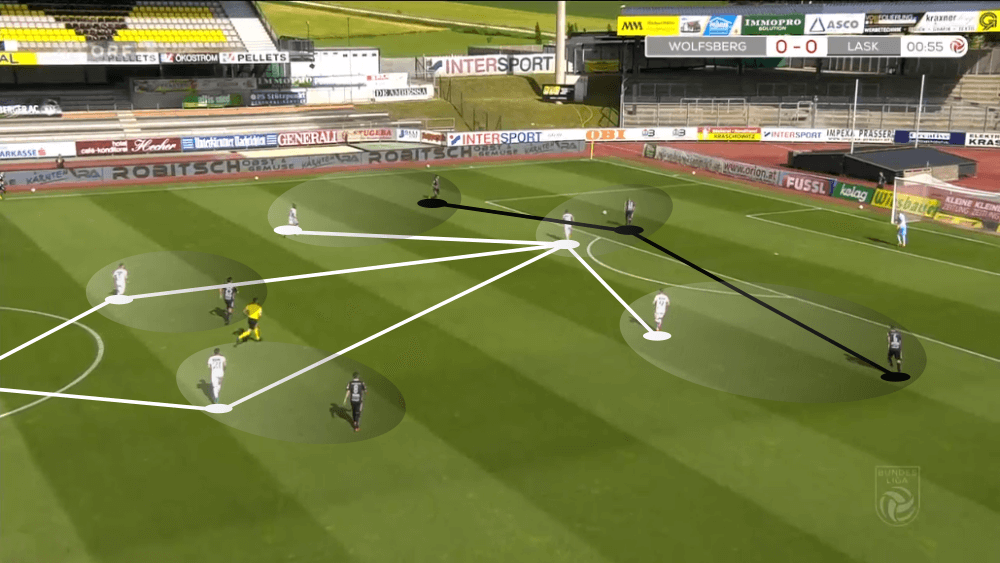
To get a basic overview of the positioning of the players of both teams during the build-up of LASK, I created the following graphic. The wing-backs of Linz are positioned wide and near the touchline while the wingers shift in to position in the half-spaces. The first idea behind the positioning of Frieser and Balić is that they shouldn’t be in the same vertical line as the wing-backs since then they would eliminate on each side one passing option. The second aspect of this central positioning will be explained when we look at their two central ways to progress the ball.
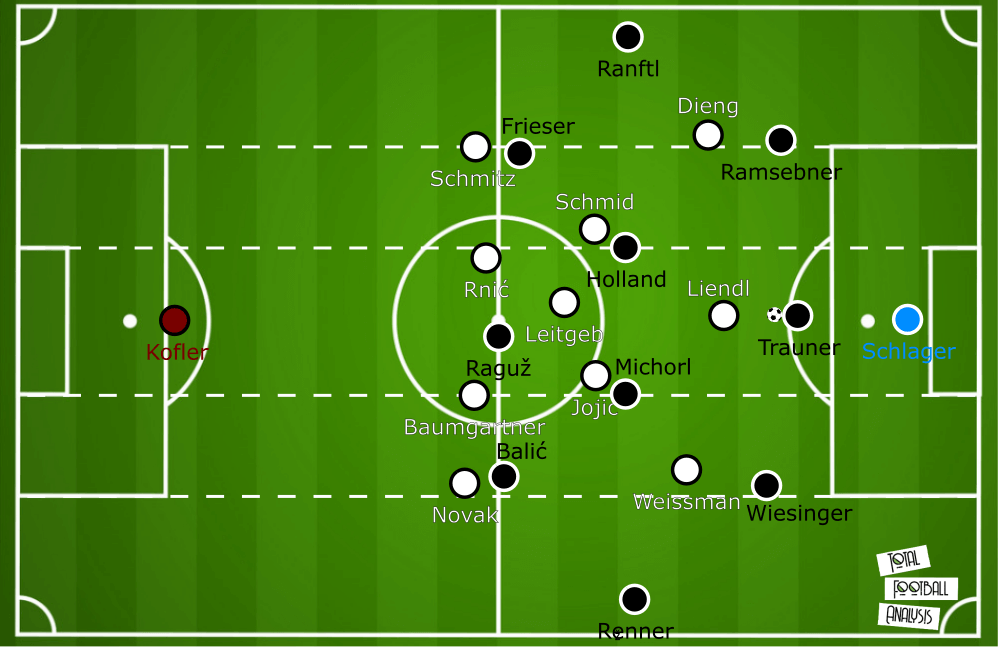
The back three of Linz constantly faced three opponents and additionally, Holland and Michorl were rarely safe passing options due to Schmid and Jojić. Furthermore, WAC often pressed in high up the pitch as soon as the ball was played to Wiesinger or Ramsebner (the two outer man of the back three).
Due to this, the logical option in those situations would be to pass the ball to the wing-back on the according side. To make this an actual option, Ranftl and Renner had to drop early enough to not be in the cover shadow of Weisman and Dieng respectively. In the shot below we can see a situation in which the right wing-back Ranftl came deep to receive the ball.
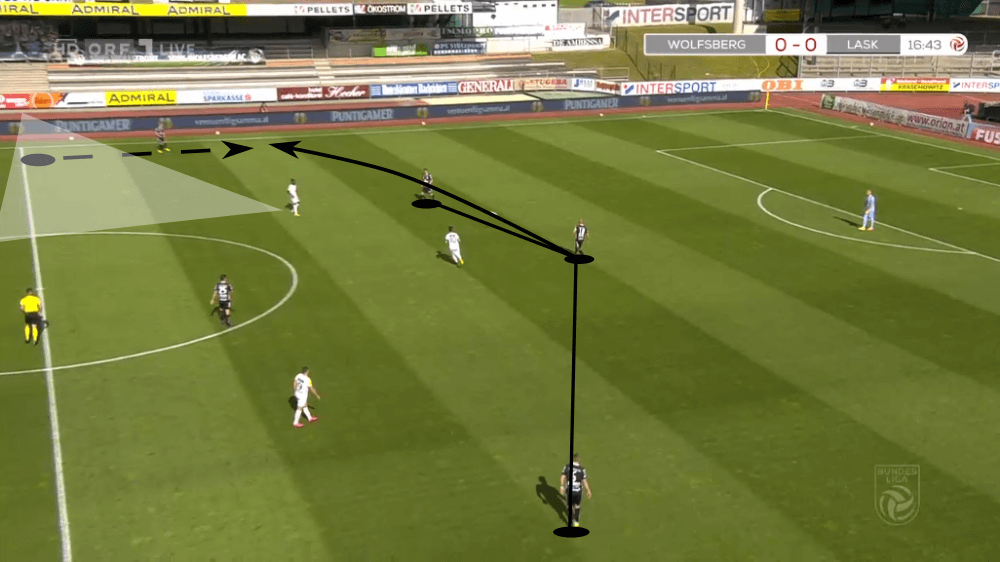
The wing-backs had in those moments (at the first glance) a lot of space and time since Wolfsberger AC played without any real wingers and the full-backs weren’t always proud enough to push forward that high. However, the striker, as well as the central midfielder, immediately put pressure on the wing-back as soon as he received the ball.
On the other hand, the idea of LASK was that Renner and Ranftl should play the ball as soon as possible back into the centre with a diagonal ball towards the front three. Therefore, we could often see that the two wing-backs played this pass with the first or second touch. This was the first out of two patterns which Linz mainly used for the progression of the ball and to have enough bodies in the centre the two wingers had to shift in.
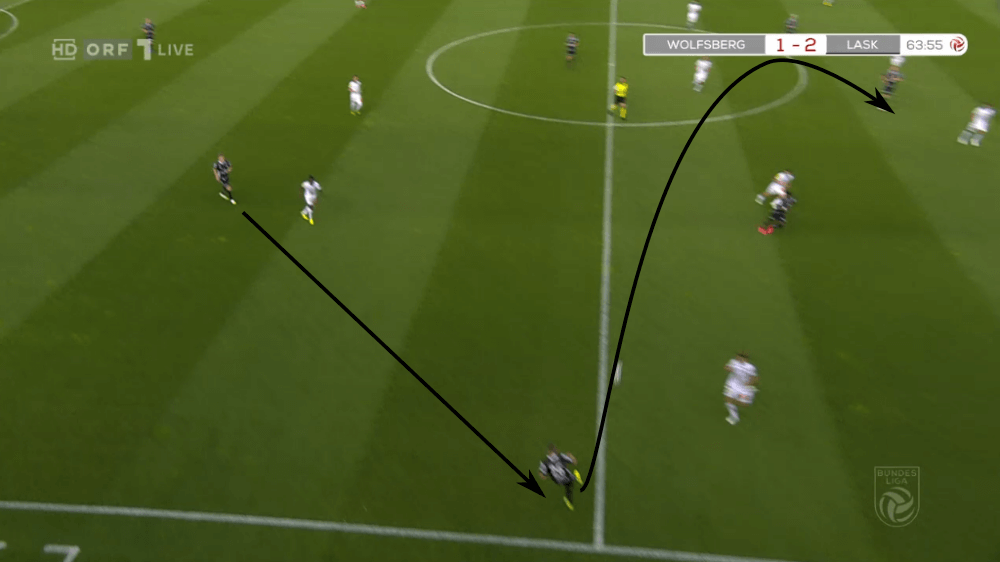
In some moments this was indeed not the right solution since Michorl or Holland were in the centre completely free. Ranftl immediately played the ball diagonally towards the three forwards without always scanning if there was another option.
In other situations, the full-backs of Wolfsberger AC were brave enough to early push forward to then be near the wing-backs of Linz when they received the ball. An example can be seen below in which the right-back Novak pushed early enough forward to give Renner absolutely no time to plan his next action and he blocked the pass.
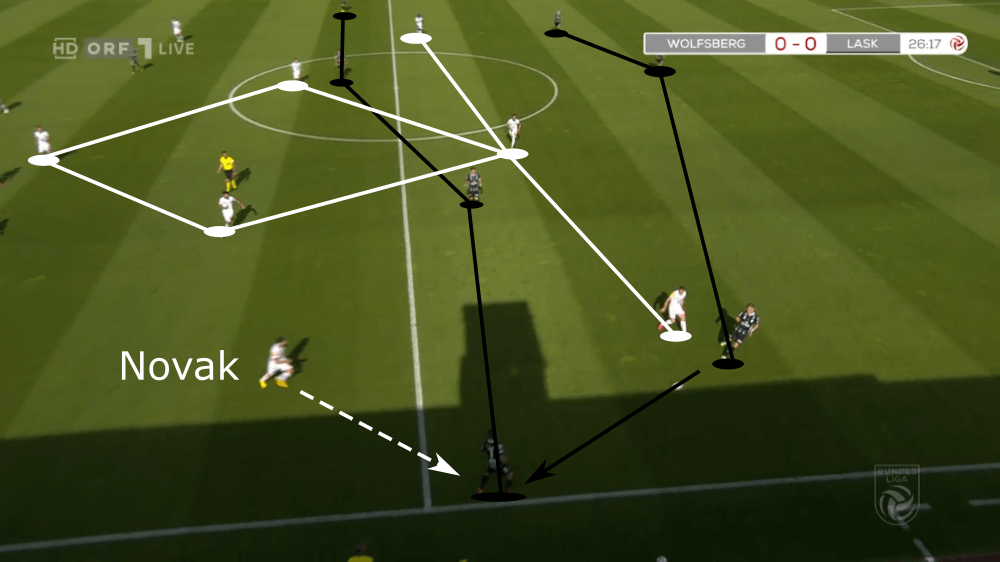
The second pattern to get forward beside the diagonal ball by the wing-backs were long balls which are typical for the team of Ismaël. These are played towards the tall central striker Raguž and the wingers are positioned centrally to have enough men around the striker to win the second ball. This concept has been used during the possession phase and the offensive transition. In the shot below we can see an example for that.
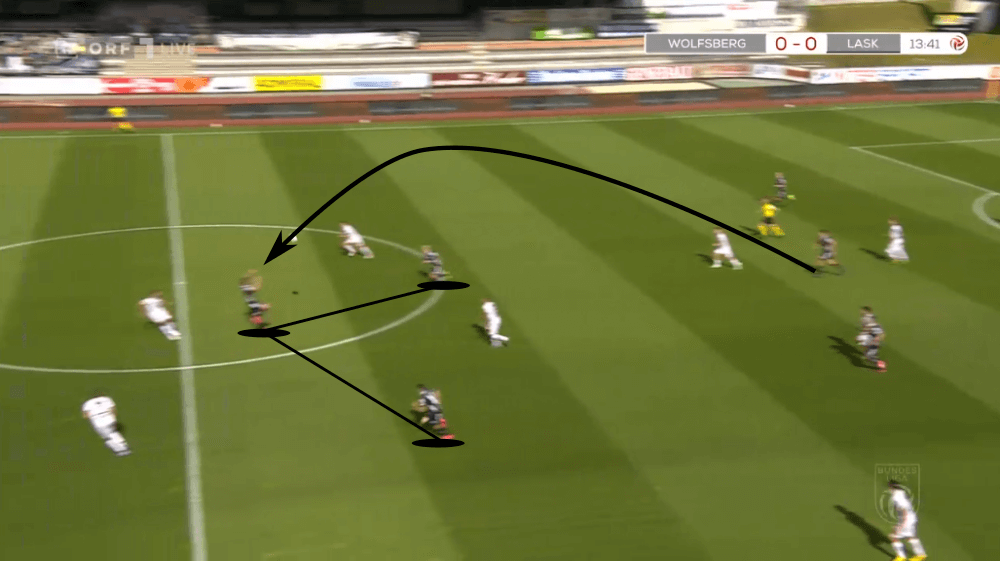
As soon as they were able to get into the final third, give and goes were the main way to get into the space behind the defence of WAC and from there they delivered crosses. One idea was then also to use the deeper position of Ranftl and Renner compared to the full-backs of Wolfsberger AC as they could pick up speed when they started a deep run. The first goal of the game resulted out of exactly such a give and go as Raguž found Ranftl with a through pass who delivered a low cross towards Frieser who just had to tap it in. Again, the fact that the right-winger converts in the six-yard box a cross of the right wing-back into a goal is an example for the central positioning of the wingers.
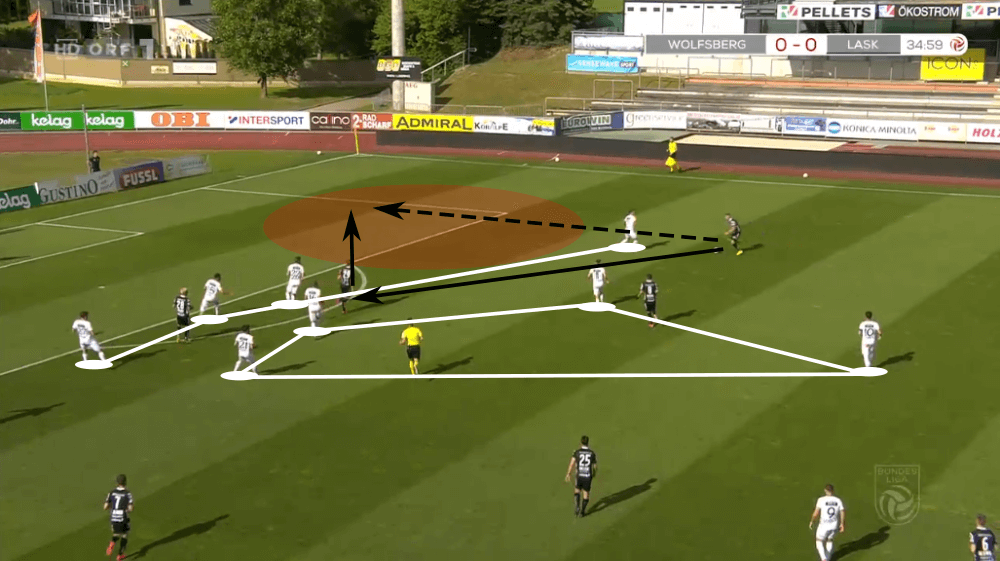
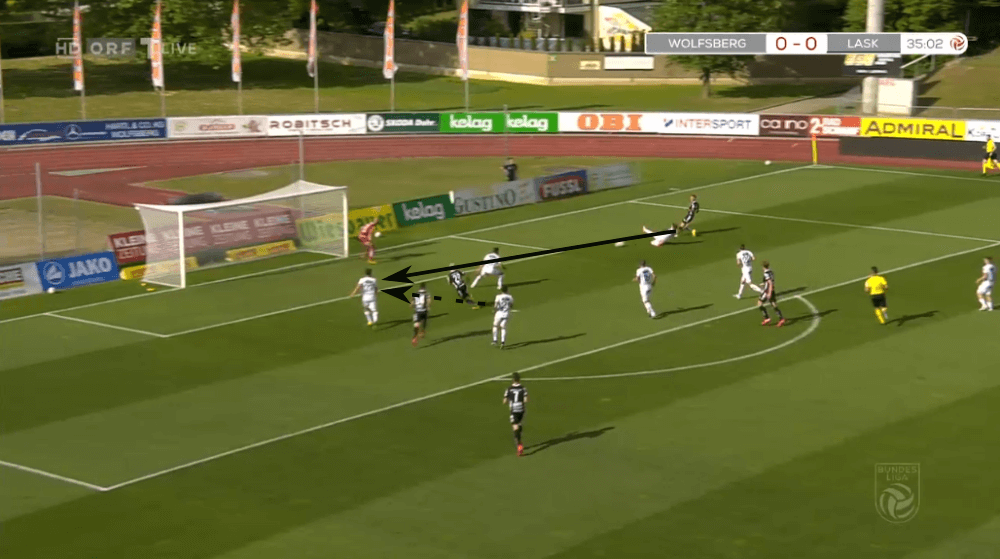
Strikers in the wide-areas during the offensive transition
LASK Linz is in this season also that incredibly strong due to their aggressive and decent counter-press. This aspect is just one of many which led to numerous sequences in which no team was able to have several successful passes after one and another (as we already saw in the stats earlier in this analysis). The press of both teams, the counter-press of Linz and because of these defensive tactics the constant drive of both teams to play as quickly as possible forward were the reasons why the game was so hectic.
However, the idea of WAC was to hit the opposition on the counter-attack since as soon as they were able to overcome the counter-press, the team of Ismaël often only had the back three as rest defence. One central man when it came to these counter-attacks was Schmid who is incredibly strong on the ball and tried several times to free himself with a dribble to then play the ball forward. In the image below we can see a situation in which the young Austrian was able to overcome the counter-press of LASK.
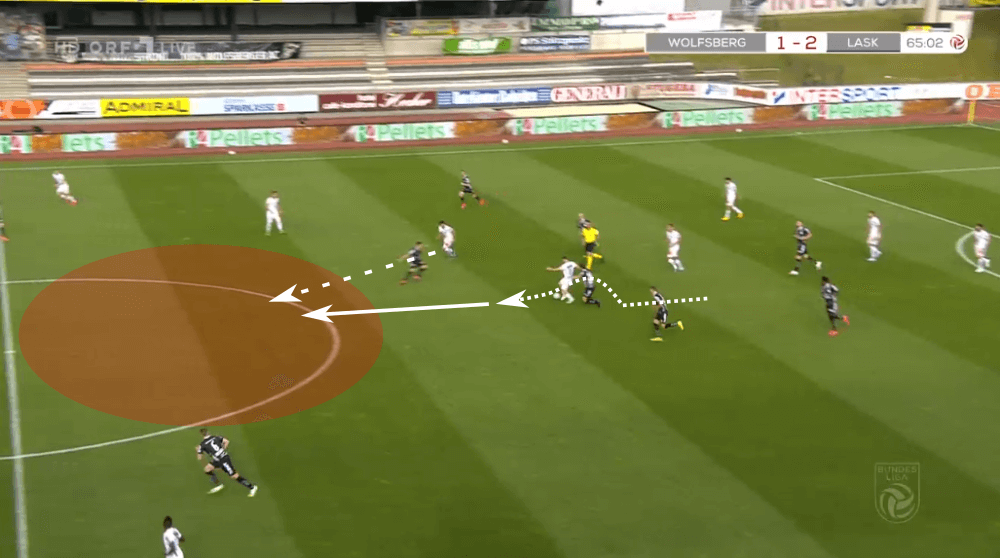
Now, when we think back to when we discussed the defensive tactics of WAC, we remember that the two strikers split wide as the back three of LASK Linz did and Liendl was positioned near them. The positions of Nieng and Weissman also had an additional reason: they were already positioned in the wide-areas when the counter-attack of their squad started.
They wanted to attack especially the wings during the offensive transition due to the high positioning of the wing-backs and besides, they wouldn’t get into direct duels with the defensively strong Trauner. In the two images below, we can see for each striker a situation in which they are positioned wide during the counter-attack since there was their preferred space.
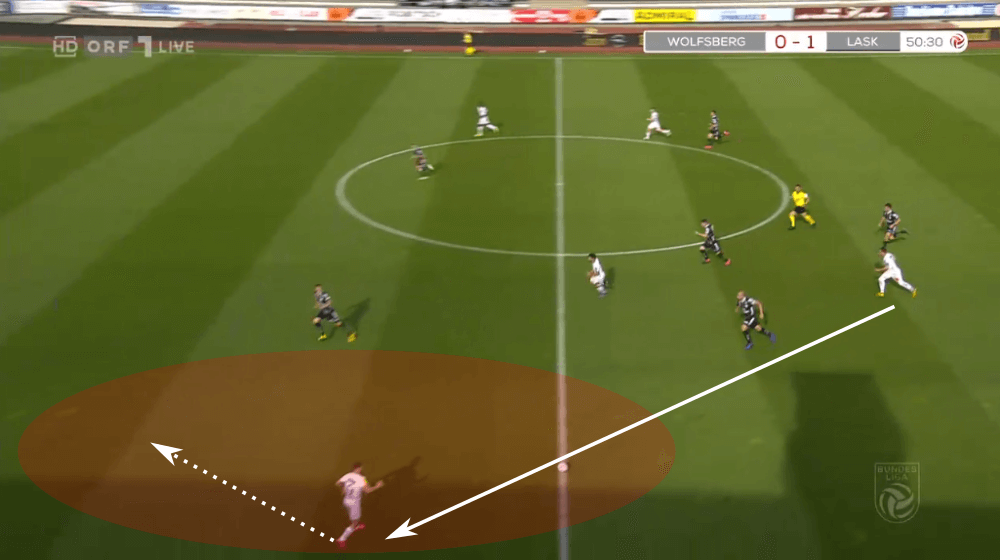
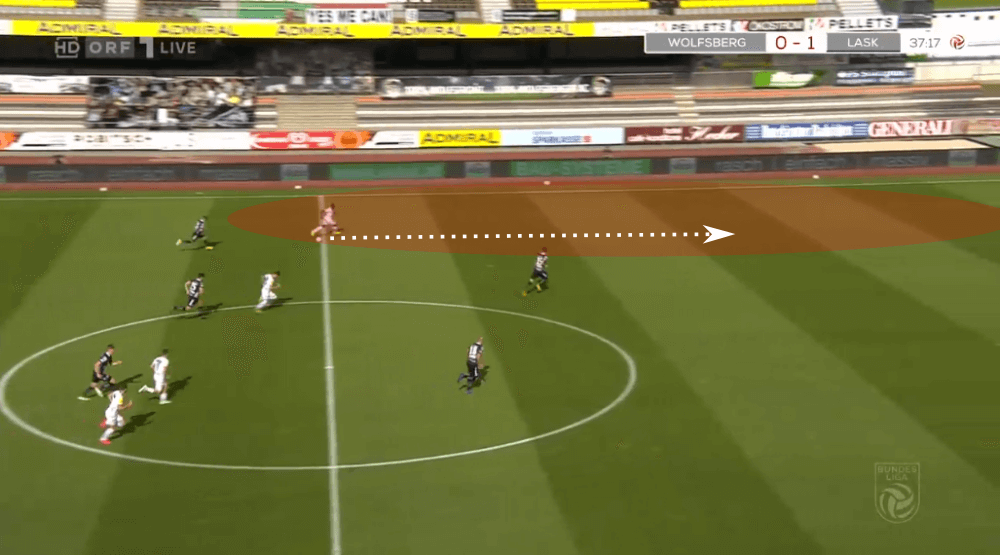
WAC’s build-up and attacks
On the other side, we had a similar picture when Wolfsberger AC were in possession since also LASK pressed quite high during the majority of the game. During the build-up, Feldhofer’s men stayed in their 4-diamond-2 formation and the full-backs were positioned wide while Leitgeb stayed deep and Schmid and Jojić, as well as the two strikers further up the pitch, occupied the half-spaces. Michorl and Holland looked after their two opponents in the centre as we saw it another way around during the build-up of LASK Linz. Leitgeb was mainly in the space between the midfield four and the three forwards. We can see in the image below how it looked like during the first stage of the build-up of WAC.
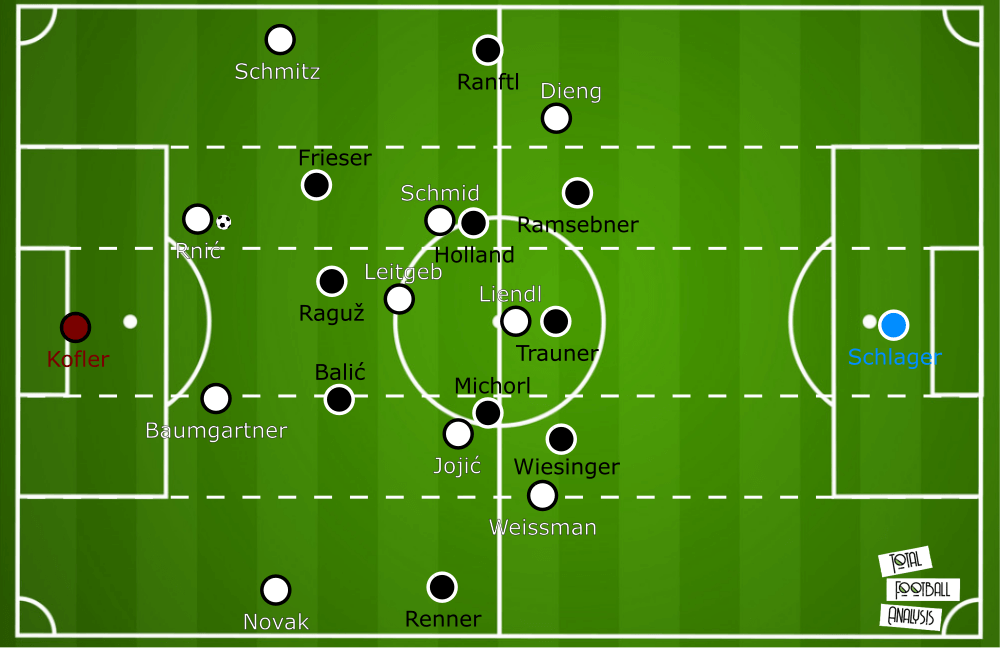
While Feldhofer’s team created a 3 vs 3 situation in the highest line during their high press , LASK had during their pressing a numerical disadvantage with their three forwards against the back four of Wolfsberger AC.
Balić, Raguž, and Frieser stayed narrow to avoid passes towards Leitgeb and provoke the ball to one of the two full-backs. As soon as this pass was played, the winger (and occasionally the wing-back) of LASK put pressure on Schmitz and Novak respectively. This basic idea of pressing was invented by the legendary AC Milan coach Arrigo Sacchi. In the shot below we can see an example of this press.
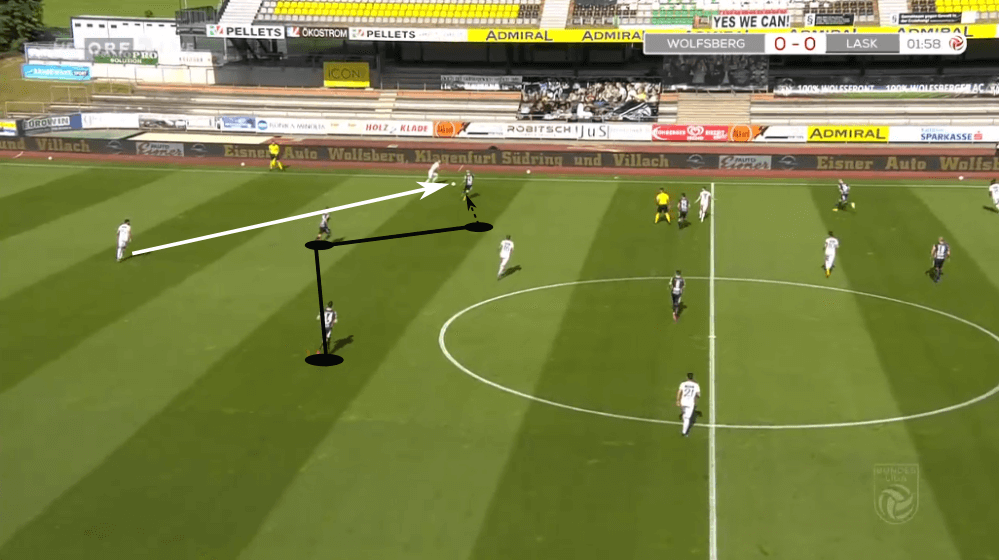
Whenever LASK didn’t press in at their opponents and they sia back deeper, we could see how the two wing-backs dropped about on the same height as the three central defenders to create a back five. Meanwhile, Frieser and Balić stayed in the same line with Raguž.
This created their typical 5-2-3 formation and once more they focused especially on avoiding passes through the centre. Michorl and Holland occupied the middle while the front three was positioned narrow to give Wolfsberger AC not much of a chance to enter the centre.
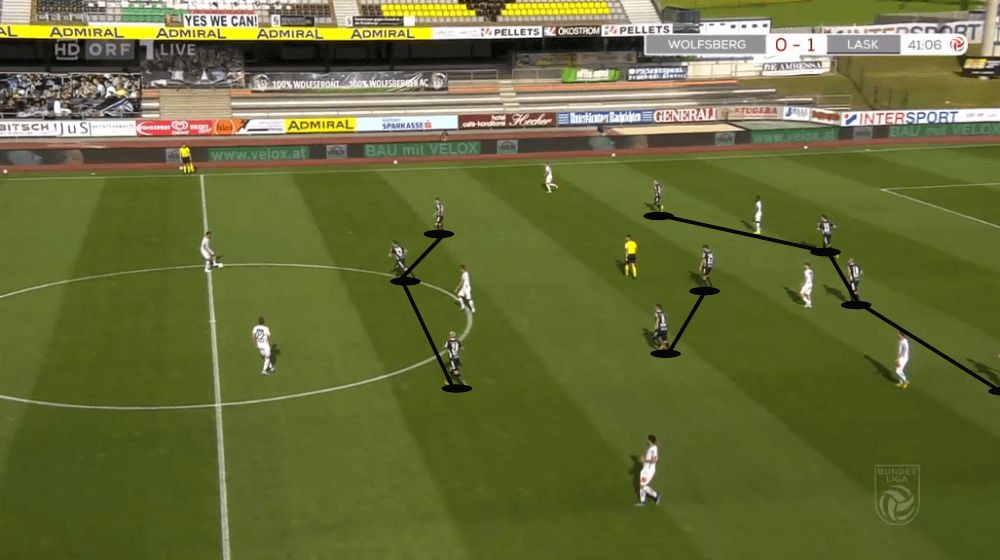
Even though the whole team of WAC play in this season was on an incredibly high level, two players clearly stand out: Liendl and Weissmann. While Liendl is the captain of the team and one of the most creative players of the league, Weissmann is, besides Christoph Monschein and Patson Daka, the best striker of the Austrian Bundesliga.
After this match, Liendl made in this season 16 assists and scored seven times while Weissman scored incredible 23 goals and provided four assists. We saw throughout this game that LASK permanently put pressure on these two men with two players as soon as they have received the ball.
Wolfsberger AC are the team in the Austrian Bundesliga with the most attempted crosses (16.44 per 90 minutes). Considering this, Feldhofer’s side often use them when they reach the final third and we saw this once again in this match. Also, the second goal of Wolfsberger AC resulted out of a cross as we can see below. Weissman brought the ball into the centre where Schmid laid it off for Liendl who scored with a beautiful volley.
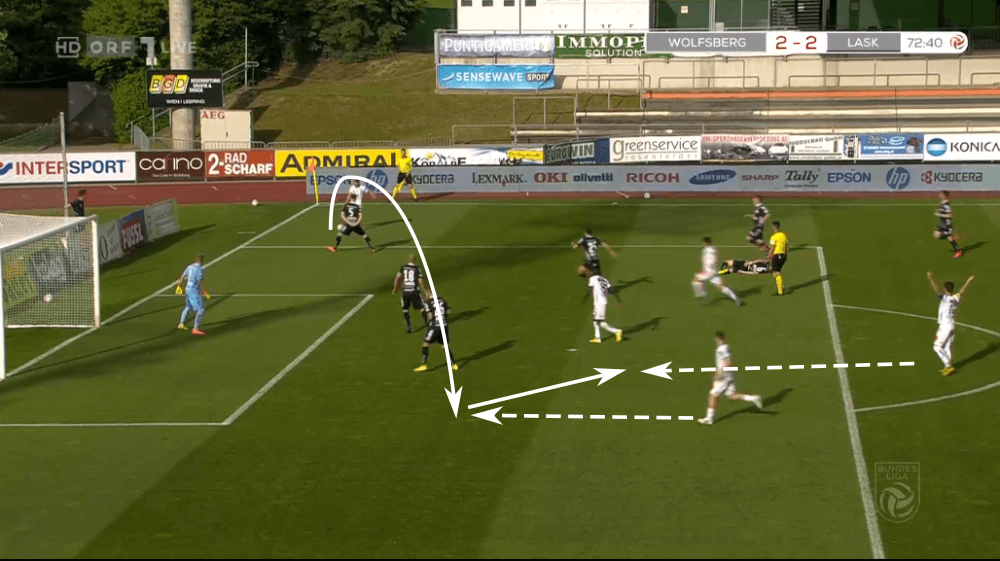
Conclusion
In the end, this draw helps none of the two teams in the race for the second place and since RB Salzburg once again won, they sit even more comfortable in the first place. WAC are now with 23 points in the second position and will face in the next round Hartberg while LASK Linz will play at home against Rapid Vienna. While it looks like Salzburg will win the league once more, the fight for the second and third place is more thrilling than ever.





Comments